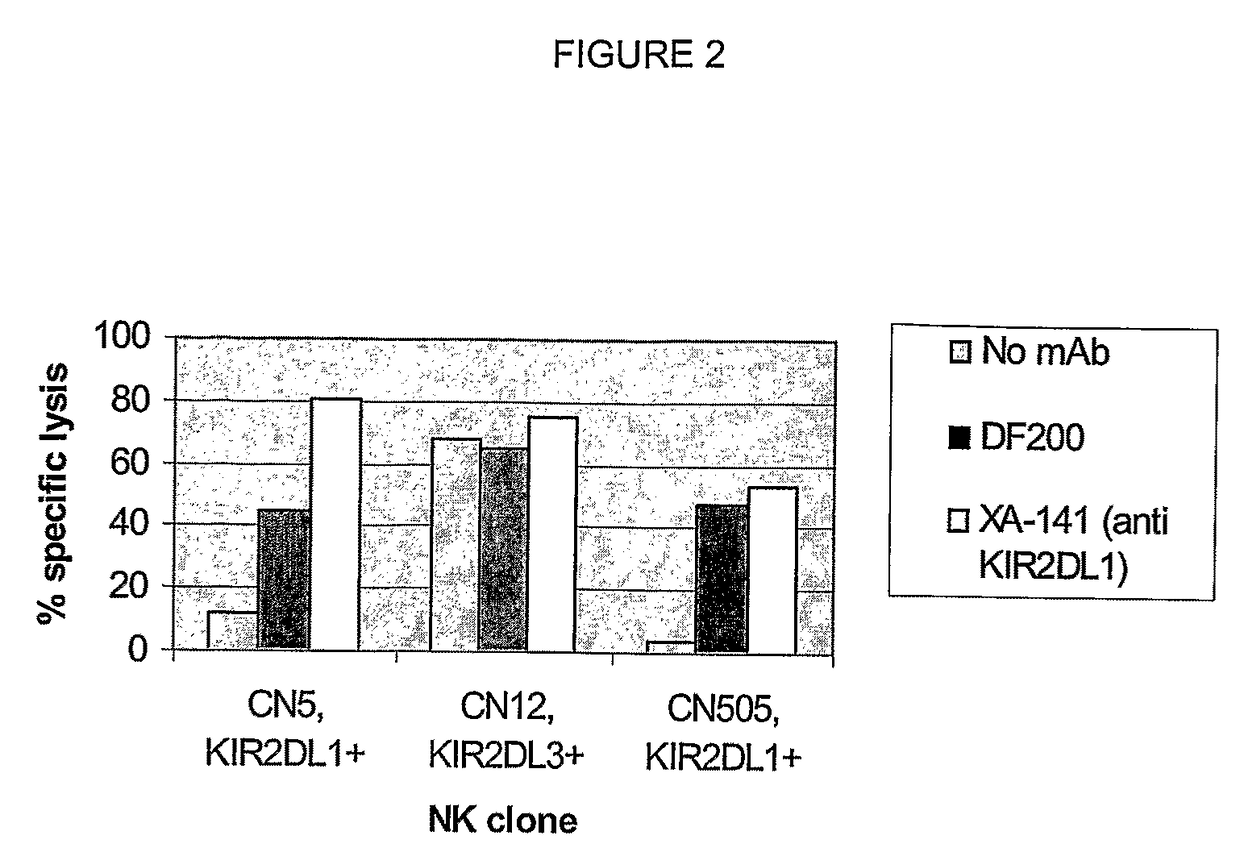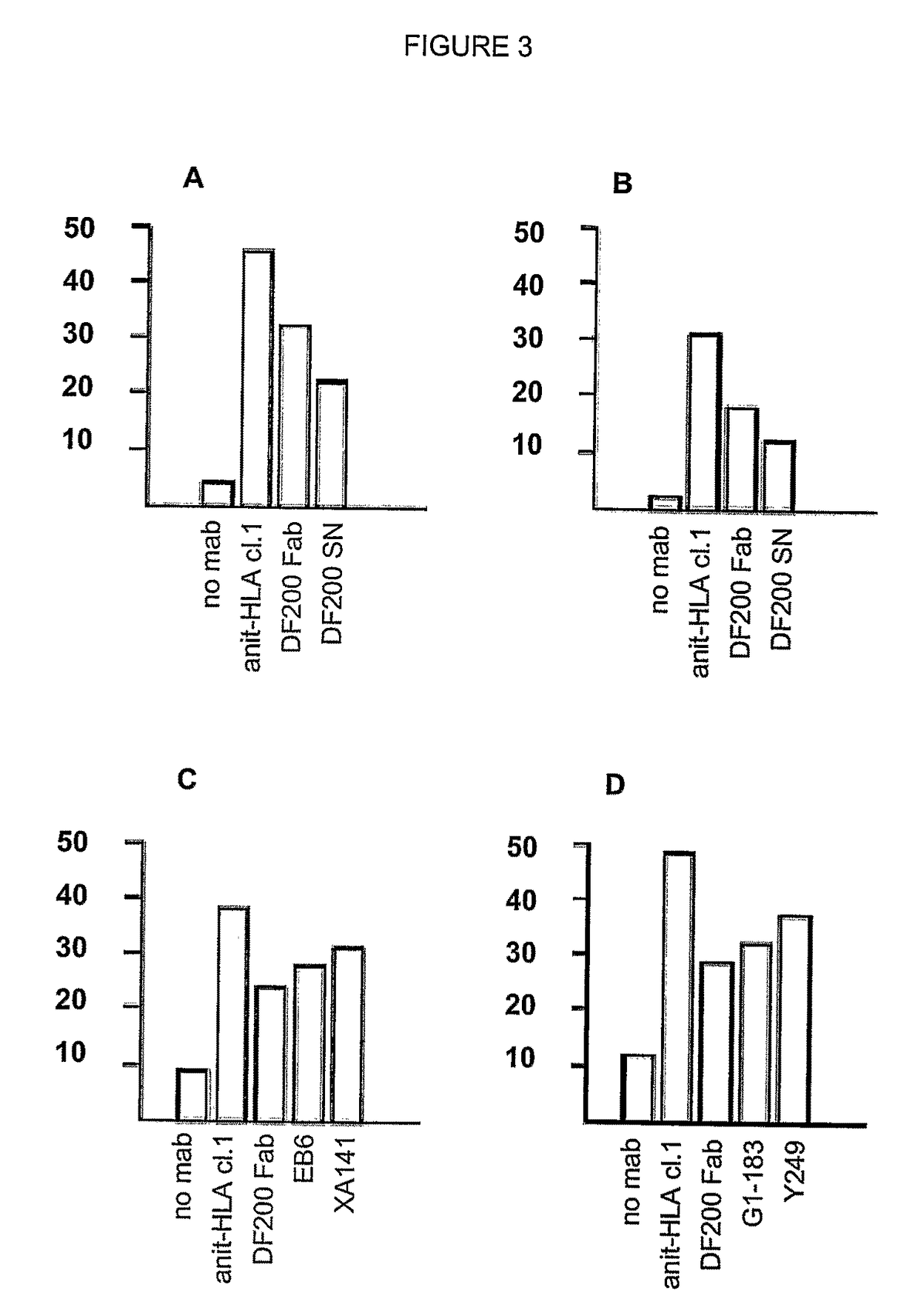Human anti-KIR antibodies
a technology antibodies, which is applied in the field of human anti-kir antibodies, can solve the problems of compromising the efficacy of treatment, antibody having the antigen-binding characteristics of nkvsf1, a210, or a803g, and not being ideal for clinical us
- Summary
- Abstract
- Description
- Claims
- Application Information
AI Technical Summary
Benefits of technology
Problems solved by technology
Method used
Image
Examples
example 1
Purification of PBLs and Generation of Polyclonal or Clonal NK Cell Lines
[0348]PBLs were derived from healthy donors by Ficoll-Hypaque gradients and depletion of plastic adherent cells. To obtain enriched NK cells, PBLs were incubated with anti-CD3, anti-CD4 and anti-HLA-DR mAbs for 30 minutes at 4° C., followed by incubation with goat anti-mouse magnetic beads (Dynal) (30 minutes at 4° C.) and immunomagnetic selection by methods known in the art (Pende et al., J Exp Med 1999; 190:1505-1516). CD3−, CD4−, DR− cells were cultivated on irradiated feeder cells and 100 U / ml Interleukin 2 (Proleukin, Chiron Corporation) and 1.5 ng / ml Phytohemagglutinin A (Gibco BRL) to obtain polyclonal NK cell populations. NK cells were cloned by limiting dilution and clones of NK cells were characterized by flow cytometry for expression of cell surface receptors.
[0349]The mAbs used were JT3A (IgG2a, anti-CD3), EB6 and GL183 (IgG1, anti-KIR2DL1 and KIR2DL3, respectively), XA-141 (IgM, anti-KIR2DL1 with t...
example 2
Generation of New mAbs
[0353]mAbs were generated by immunizing 5 week old Balb / C mice with activated polyclonal or monoclonal human NK cell lines as described in (Moretta et al., J Exp Med 1990; 172:1589-1598). After different cell fusions, the mAbs were first selected for their ability to cross-react with EB6- and GL183-positive NK cell lines and clones. Positive monoclonal antibodies were further screened for their ability to reconstitute lysis by EB6-positive or GL183-positive NK clones of Cw4 or Cw3 positive targets, respectively.
[0354]Cell staining was carried out as follows. Cells were stained with a panel of antibodies (1 μg / ml or 50 μl supernatant, 30 nms at 4° C.) followed by PE-conjugated goat F(ab′)2 fragments anti-mouse IgG (H+L) or PE-conjugated goat F(ab′)2 fragment anti-human IgG (Fc gamma) antibodies (Beckman Coulter). Cytofluorometric analysis was performed on an Epics XL.MCL apparatus (Beckman Coulter).
[0355]One of the monoclonal antibodies, the DF200 mAb, was found...
example 3
Biacore Analysis of DF200 mAb / KIR2DL1 and DF200 mAb / KIR2DL3 Interactions
[0360]Production and purification of recombinant proteins. The KIR2DL1 and KIR2DL3 recombinant proteins were produced in E. coli. cDNA encoding the entire extracellular domain of KIR2DL1 (SEQ ID NO:23) and KIR2DL3 (SEQ ID NO:25) were amplified by PCR from pCDM8 clone 47.11 vector (Biassoni et al, Eur J Immunol. 1993; 23:1083-7) and RSV.5(gpt)183 clone 6 vector (Wagtmann et al, Immunity 1995; 2:439-49 and 1995; 3:801-809) respectively, using the following primers:
[0361]
(SEQ ID NO: 13)Sense:5′-GGAATTCCAGGAGGAATTTAAAATGCATGAGGGAGTCCACAG-3′Anti-sense:(SEQ ID NO: 14)5′- CGGGATCCCAGGTGTCTGGGGTTACC -3′
[0362]They were cloned into the pML1 expression vector in frame with a sequence encoding a biotinylation signal (Saulquin et al, J Exp Med. 2003; 197:933-8).
[0363]Protein expression was performed in the BL21(DE3) bacterial strain (Invitrogen). Transfected bacteria were grown to OD600=0.6 at 37° C. in medium supplemented w...
PUM
| Property | Measurement | Unit |
|---|---|---|
| dissociation constant | aaaaa | aaaaa |
| dissociation constant | aaaaa | aaaaa |
| dissociation constants | aaaaa | aaaaa |
Abstract
Description
Claims
Application Information
 Login to View More
Login to View More - R&D
- Intellectual Property
- Life Sciences
- Materials
- Tech Scout
- Unparalleled Data Quality
- Higher Quality Content
- 60% Fewer Hallucinations
Browse by: Latest US Patents, China's latest patents, Technical Efficacy Thesaurus, Application Domain, Technology Topic, Popular Technical Reports.
© 2025 PatSnap. All rights reserved.Legal|Privacy policy|Modern Slavery Act Transparency Statement|Sitemap|About US| Contact US: help@patsnap.com



